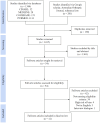Risk Factors for Acute Acquired Comitant Esotropia in Children and Young Adults: A Systematic Review
- PMID: 39246730
- PMCID: PMC11378710
- DOI: 10.22599/bioj.386
Risk Factors for Acute Acquired Comitant Esotropia in Children and Young Adults: A Systematic Review
Abstract
Background: Acute acquired comitant esotropia (AACE) is a rare subtype of esotropia that occurs after infancy. The exact pathogenesis of AACE remains unknown with aetiologies ranging from benign conditions to serious underlying neurological diseases being reported. Given the elusive characteristic of AACE, diagnostic and management guidelines remain unclear. This systematic review aims to contribute to this field by summarising the risk factors for AACE reported thus far.
Methods: A systematic review was conducted with papers found in CINAHL, MEDLINE, Cochrane library, PubMed databases and other sources. Eligible studies investigating the risk factors for, and clinical features of, AACE in children and young adults were critically appraised before relevant data were extracted and discussed via a narrative summary.
Results: Twelve studies were included in the final review, of which six and eight papers reported on benign and non-benign risk factors for AACE respectively. Identified benign risk factors varied among studies, while non-benign risk factors were associated with intracranial pathologies, multiple sclerosis and head trauma.
Conclusion: Given the low generalisability of study findings, no definitive conclusions can be drawn on the significance of each risk factor on AACE development. Further prospective research with more objective measurements of 'near work', larger sample sizes and control groups is required to better ascertain any cause-effect relationship, refine the diagnostic criteria for each AACE subtype and advise on appropriate management guidelines for AACE.
Keywords: acute acquired comitant esotropia; children; risk factors; strabismus; young adults.
Copyright: © 2024 The Author(s).
Conflict of interest statement
The authors have no competing interests to declare.
Figures
References
-
- Armenti, S.T., Miller, J.M.L., Gomez-Hassan, D., Gappy, C. and Cornblath, W.T. (2021) ‘Multiple sclerosis presenting as acute acquired comitant esotropia in a pediatric patient’, Journal of American Association for Pediatric Ophthalmology and Strabismus, 25(1), pp. 45–47. Available at: DOI: 10.1016/j.jaapos.2020.08.006 - DOI - PubMed
-
- Astle, W.F. and Miller, S.J. (1994) ‘Acute comitant esotropia: a sign of intracranial disease’, Canadian Journal of Ophthalmology, 29(3), pp. 151–154. - PubMed
LinkOut - more resources
Full Text Sources


